| BrianRxm | Old Coins | 3/9 |
Greek Coins
Some coins from various ancient Greek Empires
| Prev | Back | Next |
Some coins from various ancient Greek Empires.
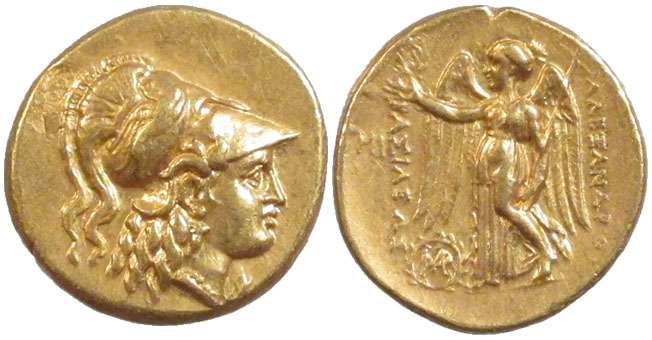
1. Alexander the Great Stater Babylon
Gold, 20 mm, 8.56 gm
Struck: BC 311-305 (about) Babylon
Obverse:
Helmeted head of Athena facing right with griffin or serpent on helmet
Reverse:
Nike standing left, holding wreath, MI on left, monogram in wreath below right wing
BAΣIΛEΩΣ AΛEΞANΔPOY (King Alexander)
Struck: BC 311-305 (about) Babylon
Helmeted head of Athena facing right with griffin or serpent on helmet
Nike standing left, holding wreath, MI on left, monogram in wreath below right wing
BAΣIΛEΩΣ AΛEΞANΔPOY (King Alexander)
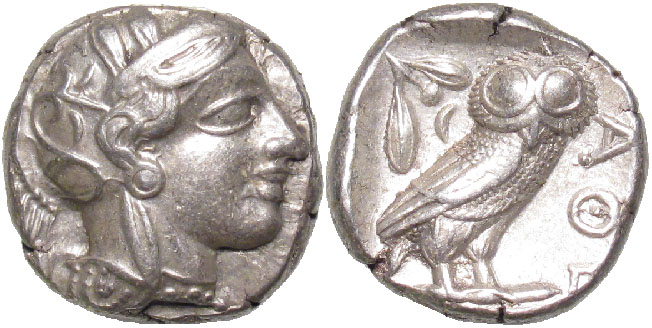
2. Athens Classical Owl Tetradrachm
Silver, 23 mm, 17.18 gm, struck around BC 430
Obverse:
Head of Athena facing right with beaded necklace,
three small upright olive leaves on front edge of Attic helmet
Reverse:
Owl leaning right, head facing, olive twig with two leaves and crescent moon
Legend AΘE (Ethnic legend)
Head of Athena facing right with beaded necklace,
three small upright olive leaves on front edge of Attic helmet
Owl leaning right, head facing, olive twig with two leaves and crescent moon
Legend AΘE (Ethnic legend)
A tetradrachm was four drachms, a drachm was a standard Greek coin at the time.
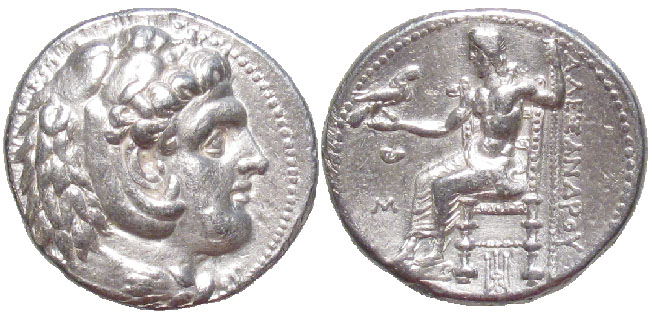
3. Alexander the Great Tetradrachm Babylon Lifetime issue
Silver, 27 mm, 17.10 gm
Struck: BC 325-323 Babylon
Obverse:
Head of Alexander facing right as Herakles wearing lion-skin headdress
Reverse:
Zeus seated left holding eagle in right hand and scepter in left hand
Astragalos and M in left field, monogram (WΦ) under throne
AΛEΞANΔPOY (Alexander)
Struck: BC 325-323 Babylon
Head of Alexander facing right as Herakles wearing lion-skin headdress
Zeus seated left holding eagle in right hand and scepter in left hand
Astragalos and M in left field, monogram (WΦ) under throne
AΛEΞANΔPOY (Alexander)
English name: Alexander III (The Great)
Greek name: Meγaς Aλeξanδpoς
Life span: BC 356-323
An astragalos was a gaming piece made from the knuckle-bone of a sheep or goat.
Greek name: Meγaς Aλeξanδpoς
Life span: BC 356-323
An astragalos was a gaming piece made from the knuckle-bone of a sheep or goat.
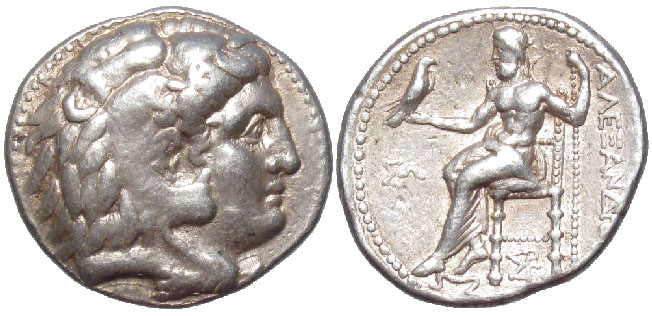
4. Alexander the Great Tetradrachm Carrhae
Silver, 27 mm, 17.15 gm
Struck: BC 315-305 Carrhae
Obverse:
Head of Herakles facing right wearing lion skin
Reverse:
Zeus seated left holding eagle in right hand and scepter in left hand
ΣΩ in left field, ΣP monogram under throne
AΛEΞANΔPOY (Alexander)
Struck: BC 315-305 Carrhae
Head of Herakles facing right wearing lion skin
Zeus seated left holding eagle in right hand and scepter in left hand
ΣΩ in left field, ΣP monogram under throne
AΛEΞANΔPOY (Alexander)
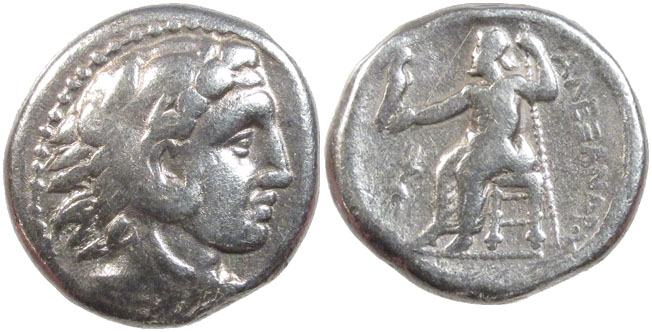
5. Alexander the Great Tetradrachm Lifetime issue (Worn)
Silver, 24 mm, 16.23 gm
Struck: BC 336-323
Obverse:
Head of Alexander as Herakles facing right wearing lion-skin headdress
Reverse:
Zeus seated left holding eagle in right hand and scepter in left hand
Thunderbolt in left field
AΛEΞANΔPOY (Alexander)
Struck: BC 336-323
Head of Alexander as Herakles facing right wearing lion-skin headdress
Zeus seated left holding eagle in right hand and scepter in left hand
Thunderbolt in left field
AΛEΞANΔPOY (Alexander)
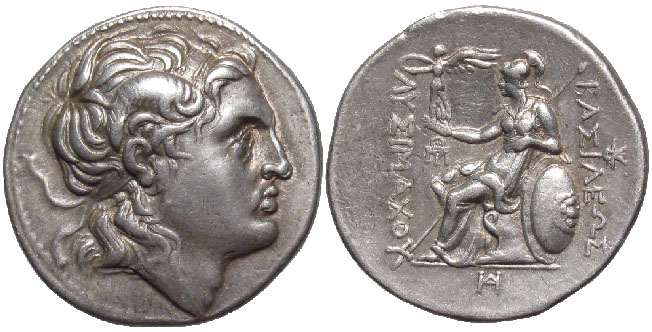
6. Lysimachus Tetradrachm Amphipolis Thrace
Silver, 30 mm, 17.14 gm
Struck: BC 288-281 (about) Amphipolis
Obverse:
Head of Alexander the Great facing right wearing the Horn of Ammon
Reverse:
Athena left on throne, resting left arm on shield, spear resting against right side
Nike crowning name
BAΣIΛEΩΣ ΛΥΣΙΜΑΧΟΥ (King Lysimachus)
Monogram ΠΥΘ on left, ΚΟ on right
ΗΜ monogram in exergue
Struck: BC 288-281 (about) Amphipolis
Head of Alexander the Great facing right wearing the Horn of Ammon
Athena left on throne, resting left arm on shield, spear resting against right side
Nike crowning name
BAΣIΛEΩΣ ΛΥΣΙΜΑΧΟΥ (King Lysimachus)
Monogram ΠΥΘ on left, ΚΟ on right
ΗΜ monogram in exergue
English name: Lysimachus or Lysimachos
Greek name: Λυσιμαχος
Life span: BC 362/361-281
Lysimachus was one of Alexander's bodyguards, a successor, and later ruler of Macedonia.
Greek name: Λυσιμαχος
Life span: BC 362/361-281
Lysimachus was one of Alexander's bodyguards, a successor, and later ruler of Macedonia.
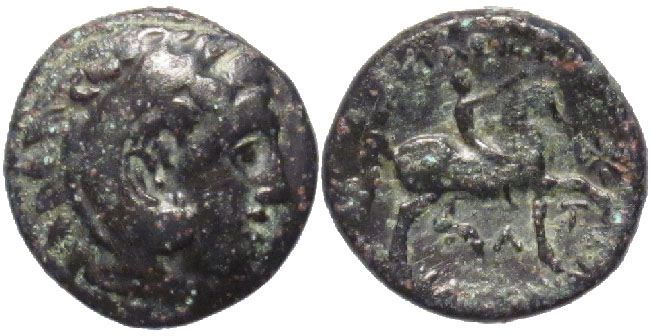
7. Kassander Copper Horseman
Bronze, 20 mm, 6.51 gm
Struck: BC 306-297 (about) Pella or Amphipolis
Obverse:
Head of Herakles facing right wearing lion skin
Reverse:
Horseman facing right, possibly Alexander on his horse Bucephalus
BAΣIΛEΩΣ KΑΣΣΑΝΔΡOY (King Kassander)
T above, star right, Λ below
Struck: BC 306-297 (about) Pella or Amphipolis
Head of Herakles facing right wearing lion skin
Horseman facing right, possibly Alexander on his horse Bucephalus
BAΣIΛEΩΣ KΑΣΣΑΝΔΡOY (King Kassander)
T above, star right, Λ below
English name: Kassander
Greek name: Kασσανδρoς
Life span: BC 350-297
Kassander was the son of one of Alexander's generals and later ruler of Macedonia.
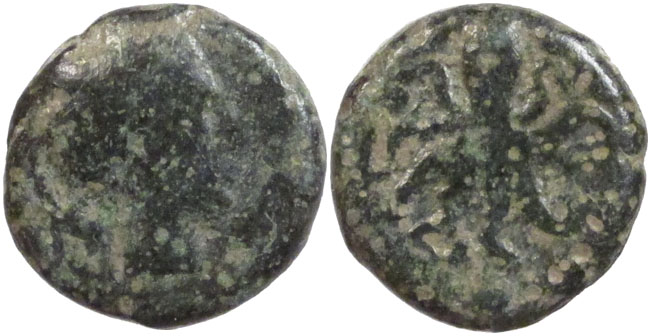
8. Syracuse Sicily Bronze Tetras Octopus
Bronze, 15 mm, 3.84 gm
Struck: BC 425-420 Syracuse mint
Obverse:
Head of Arethusa right with dolphins
Inscription ΣΥΡΑ (SYRAcuse) to right of head
Reverse:
Octopus
Struck: BC 425-420 Syracuse mint
Head of Arethusa right with dolphins
Inscription ΣΥΡΑ (SYRAcuse) to right of head
Octopus
A tetras was 1/4 of an obol, an obol was 1/6 of a drachm.
Cistophoric Tetradrachms:
The cistophorus was a coin of ancient Pergamon which circulated in Asia Minor up to the time of the Romans.
Pergamon was a city in Mysia located near the Aegean Sea coast near the island of Lesbos.
The coins continued to be minted and circulated by the Romans with different coin types and legends.
The coin obverse cista mystica or sacred chest was a basket used for housing sacred serpents in connection
with the initiation ceremony into the cult of Bacchus (Dionysus).
The coin reverse for these coins was a bow case representing Heracles.
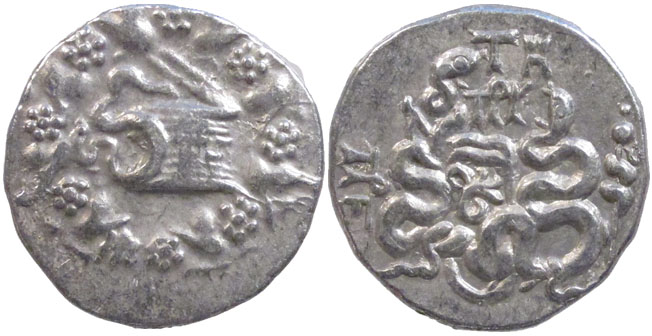
9. Cistophoric Tetradrachm of Pergamon Mysia, BC 166 to 67
Silver, 25 mm, 12.20 gm, SNG (Sylloge Nummorum Graecorum) France 1752
Struck BC 166 to 67, Pergamon
Obverse:
Cista mystica within wreath with serpent emerging from it.
Reverse:
Bow case with two entwined serpents around it.
Monogram of Pergamon ΠΕΡ to left
Staff and serpent to right, monogram ΤΗ ΠΡΥ above
Struck BC 166 to 67, Pergamon
Cista mystica within wreath with serpent emerging from it.
Bow case with two entwined serpents around it.
Monogram of Pergamon ΠΕΡ to left
Staff and serpent to right, monogram ΤΗ ΠΡΥ above
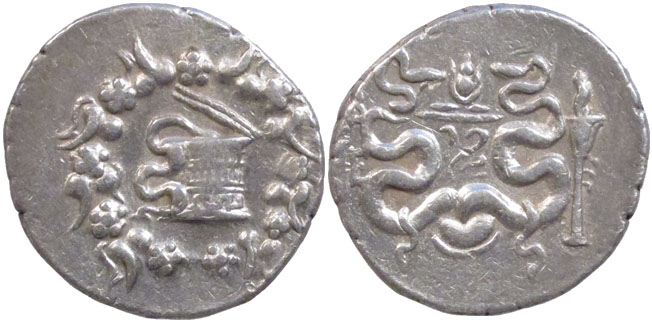
10. Cistophoric Tetradrachm of Ephesus Ionia, BC 83 to 82
Silver, 26 mm, 12.44 gm, SNG (Sylloge Nummorum Graecorum) Copenhagen 330
Struck: BC 83 to 82 Ephesus
Obverse:
Cista mystica within wreath with serpent emerging from it
Reverse:
Bow case with two entwined serpents around it, headdress of Isis above
Struck: BC 83 to 82 Ephesus
Cista mystica within wreath with serpent emerging from it
Bow case with two entwined serpents around it, headdress of Isis above
Ptolemaic Kingdom of Egypt:
The Ptolemaic Kingdom was an ancient Greek state based in Egypt. It was founded in BC 305 by
Alexander the Great's general Ptolemy I Soter, and lasted until the death of Queen Cleopatra in BC 30.
The Ptolemies ruled Egypt for almost three centuries and were the longest ancient Egyptian dynasty.
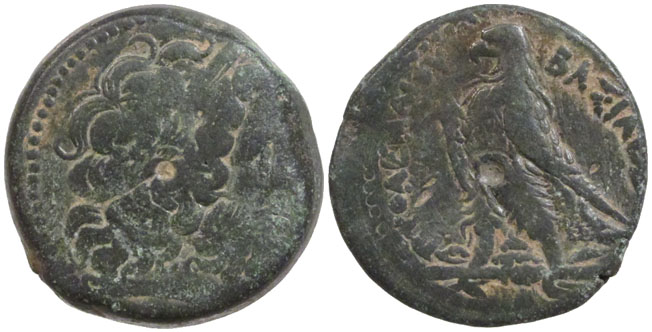
11. Ptolemaic Kingdom Egypt Bronze Ptolemy II Philadelphos BC 285-246
Bronze, 28 mm, 22.56 gm, SNG Copenhagen 156
Struck: BC 267 Alexandria
Obverse:
Laureate head of Zeus-Ammon facing right
Reverse:
Eagle with folded wings standing left on thunderbolt, Δ between legs
ΠTOΛEMAIOY BAΣIΛEΩΣ (Ptolemy King)
Struck: BC 267 Alexandria
Laureate head of Zeus-Ammon facing right
Eagle with folded wings standing left on thunderbolt, Δ between legs
ΠTOΛEMAIOY BAΣIΛEΩΣ (Ptolemy King)
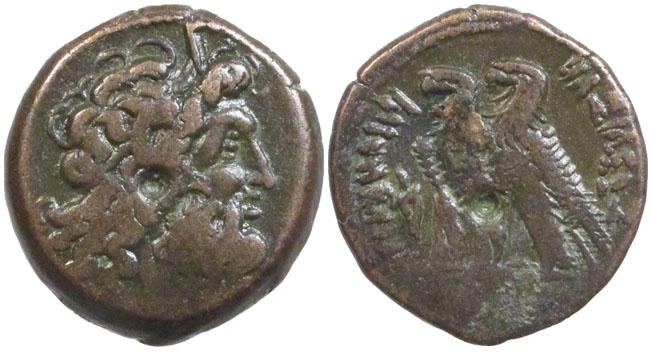
12. Ptolemaic Kingdom Egypt Bronze Ptolemy IX to XII BC 116-51
Bronze, 20 mm, 7.02 gm, SNG Copenhagen 311-4
Struck: BC 116-51 Alexandria
Obverse:
Laureate head of Zeus-Ammon right
Reverse:
Two eagles with wings closed standing left on thunderbolt; cornucopia to left
ΠTOΛEMAIOY BAΣIΛEΩΣ (Ptolemy King)
Struck: BC 116-51 Alexandria
Laureate head of Zeus-Ammon right
Two eagles with wings closed standing left on thunderbolt; cornucopia to left
ΠTOΛEMAIOY BAΣIΛEΩΣ (Ptolemy King)
| Prev | Back | Next |